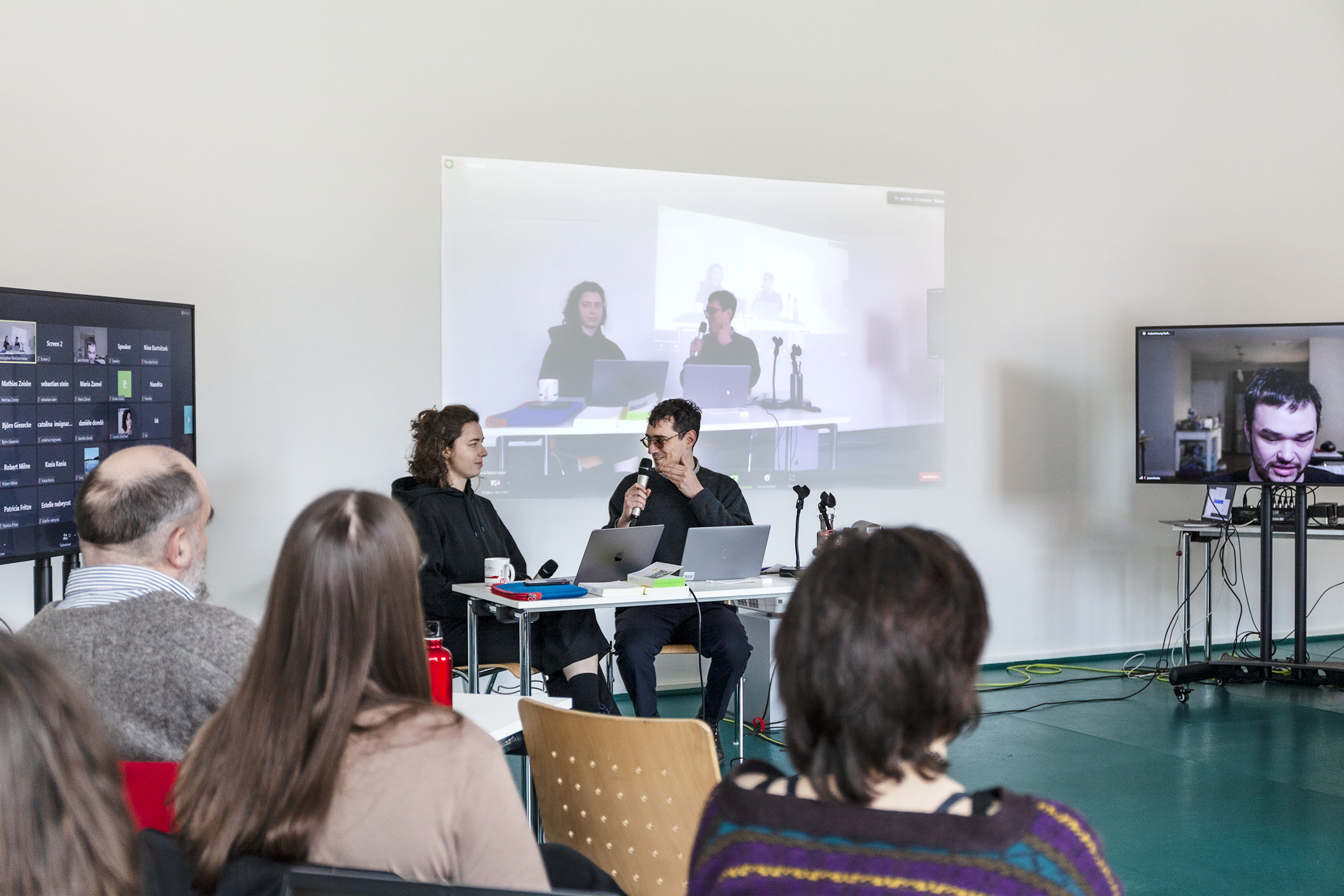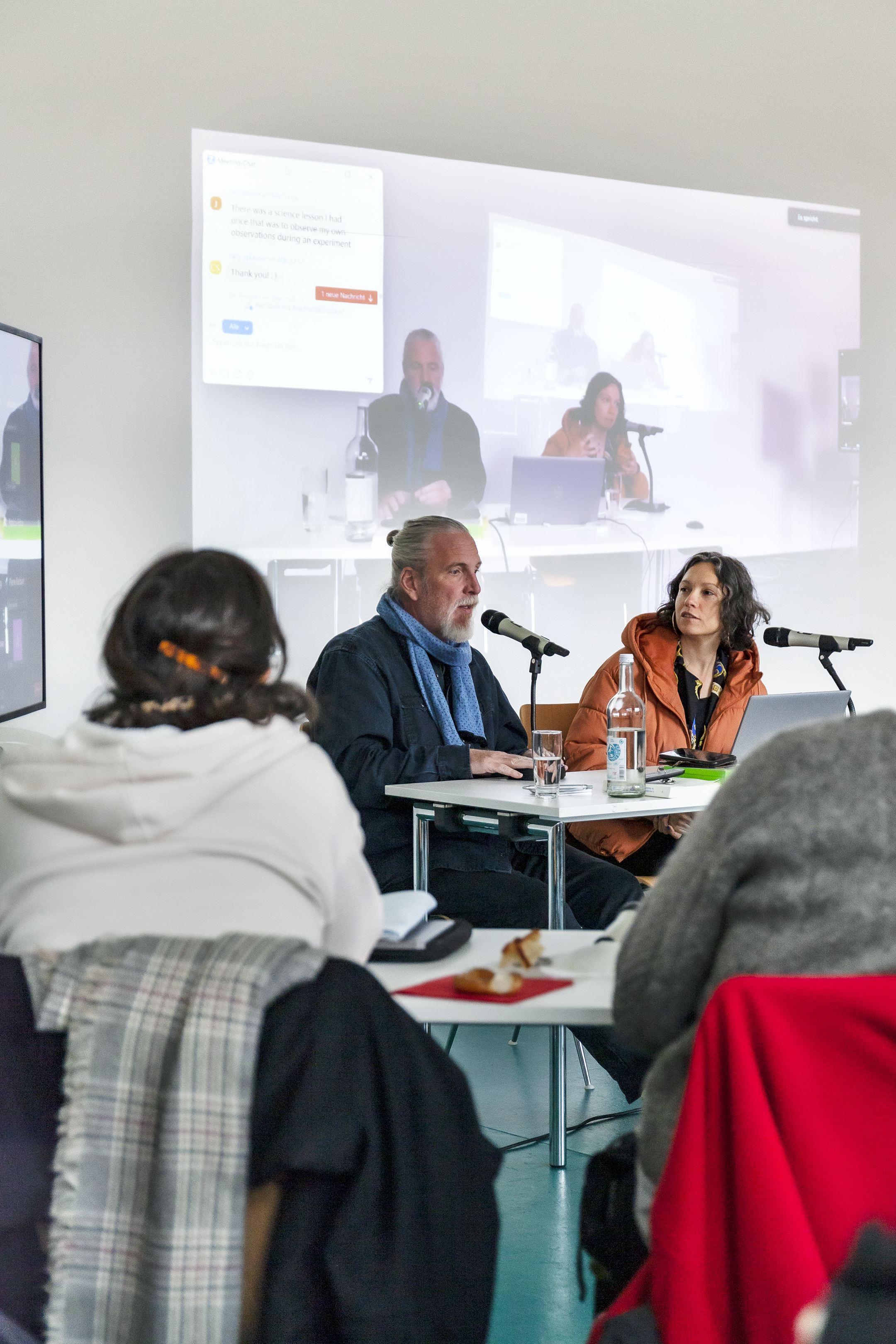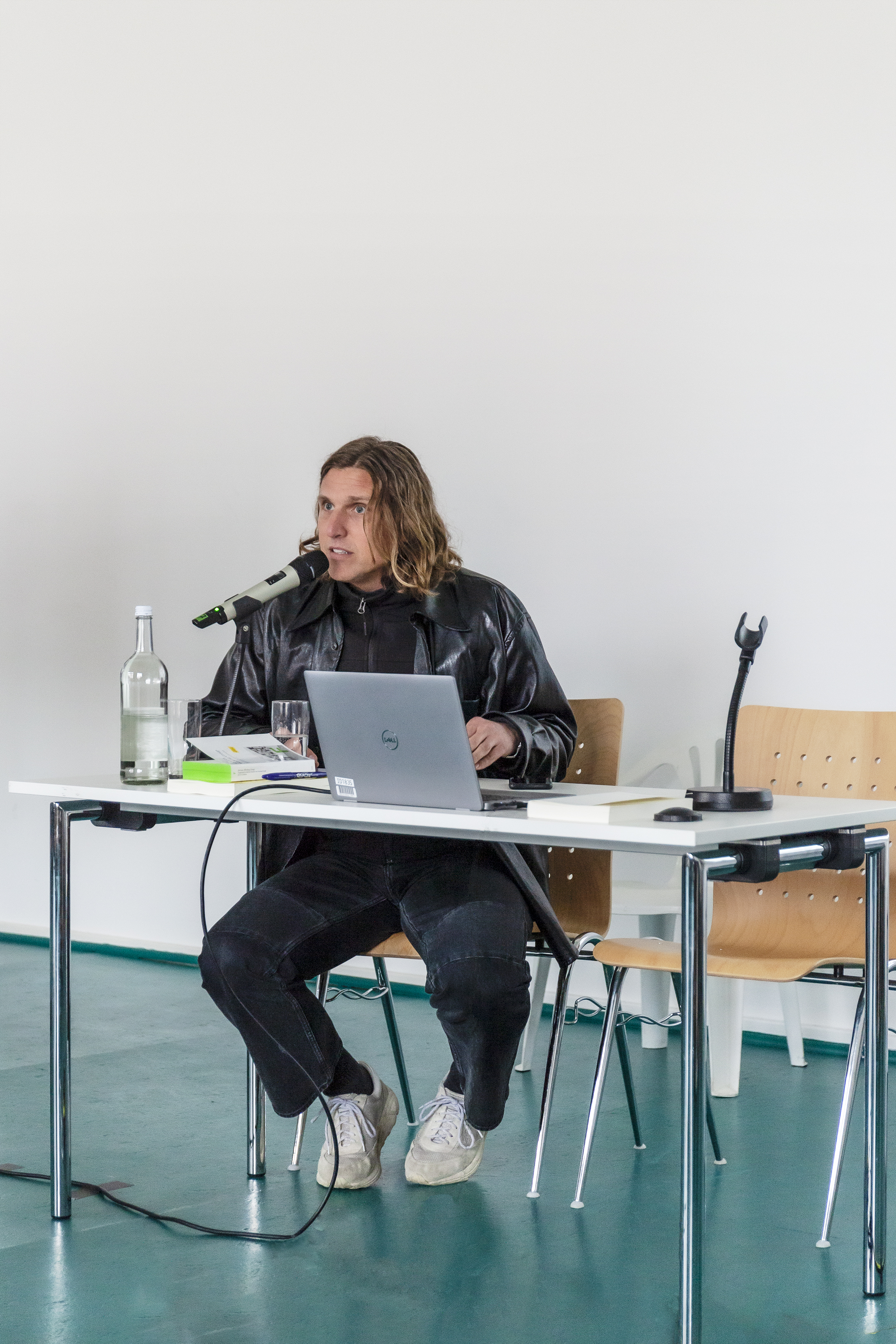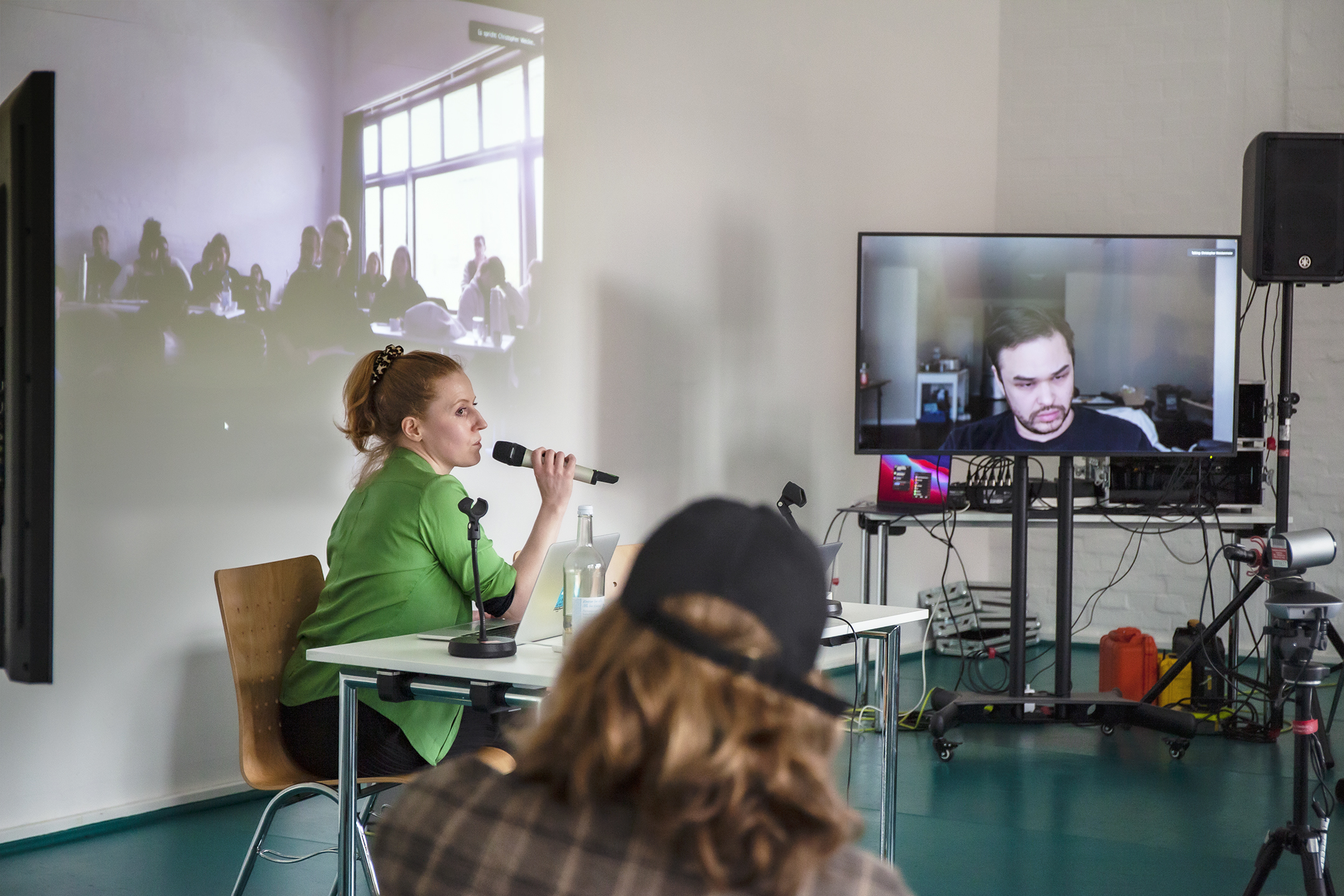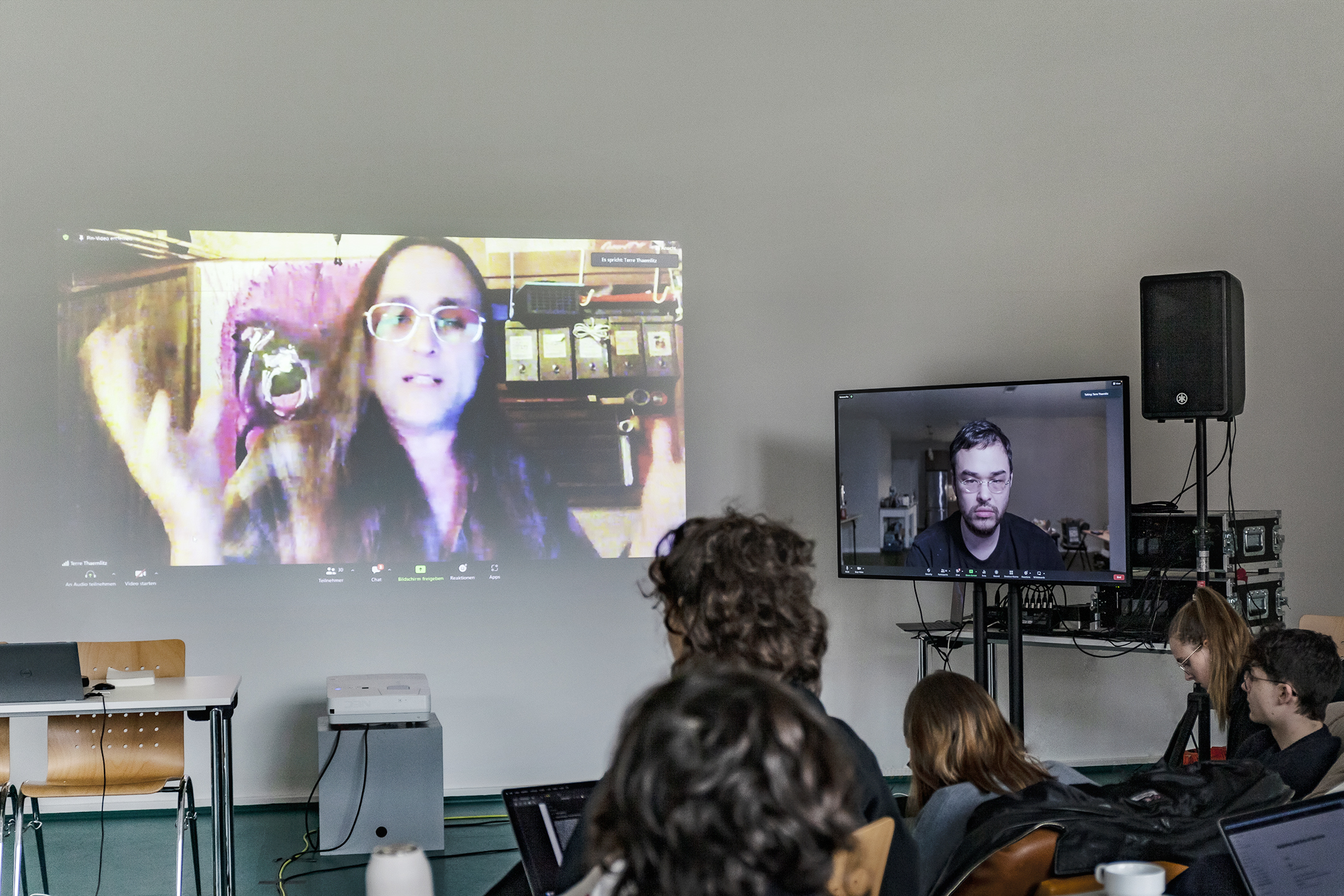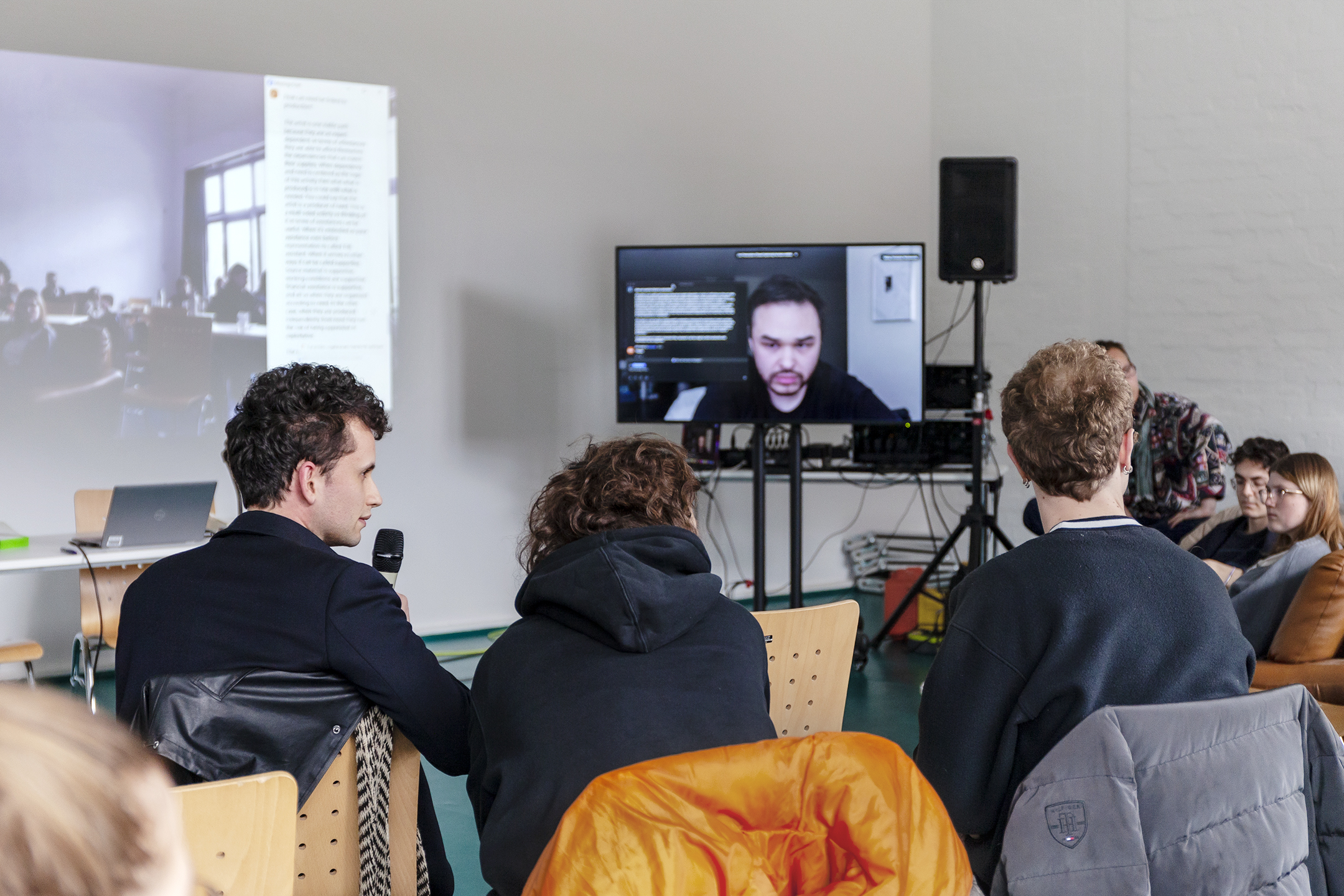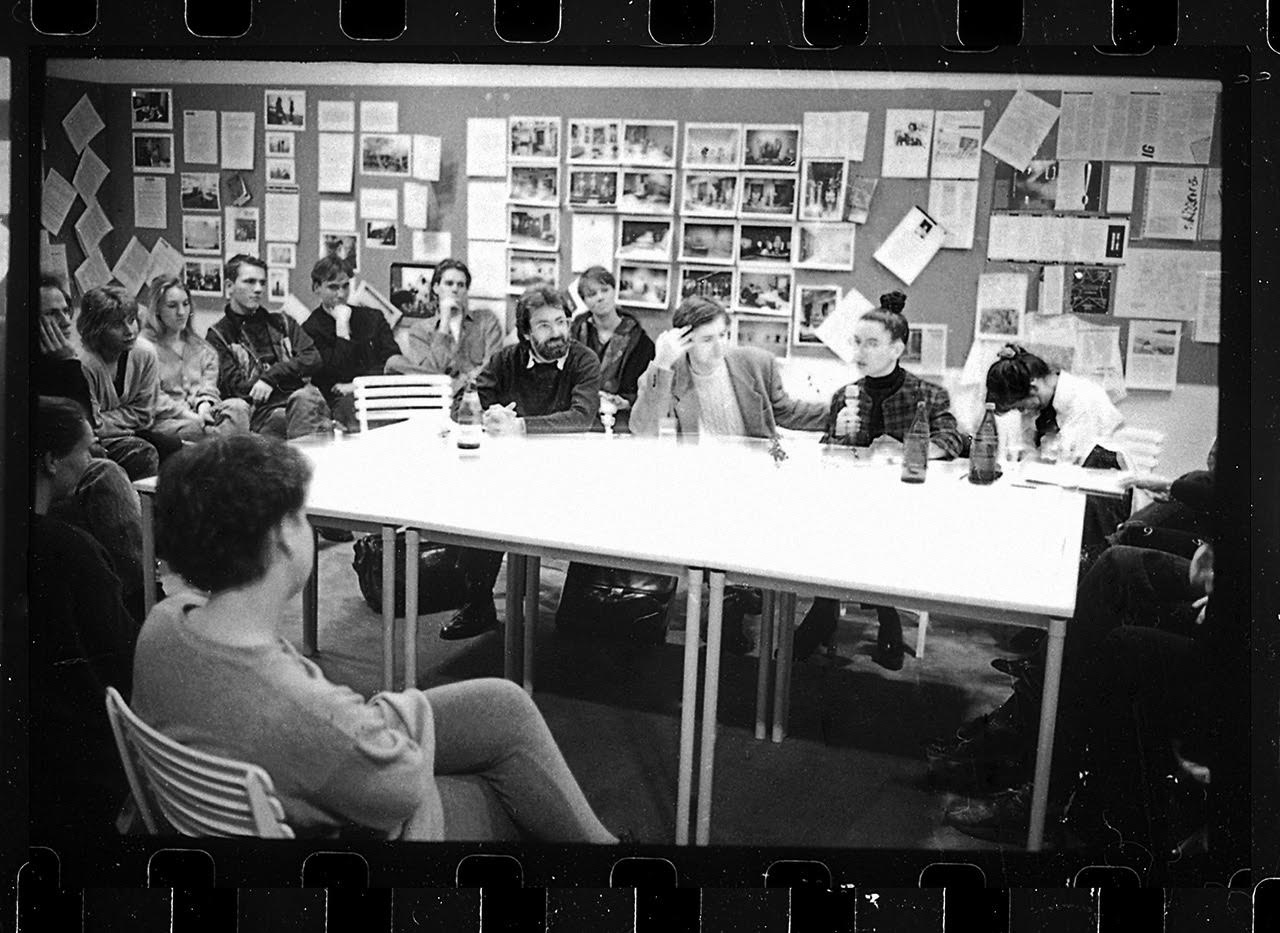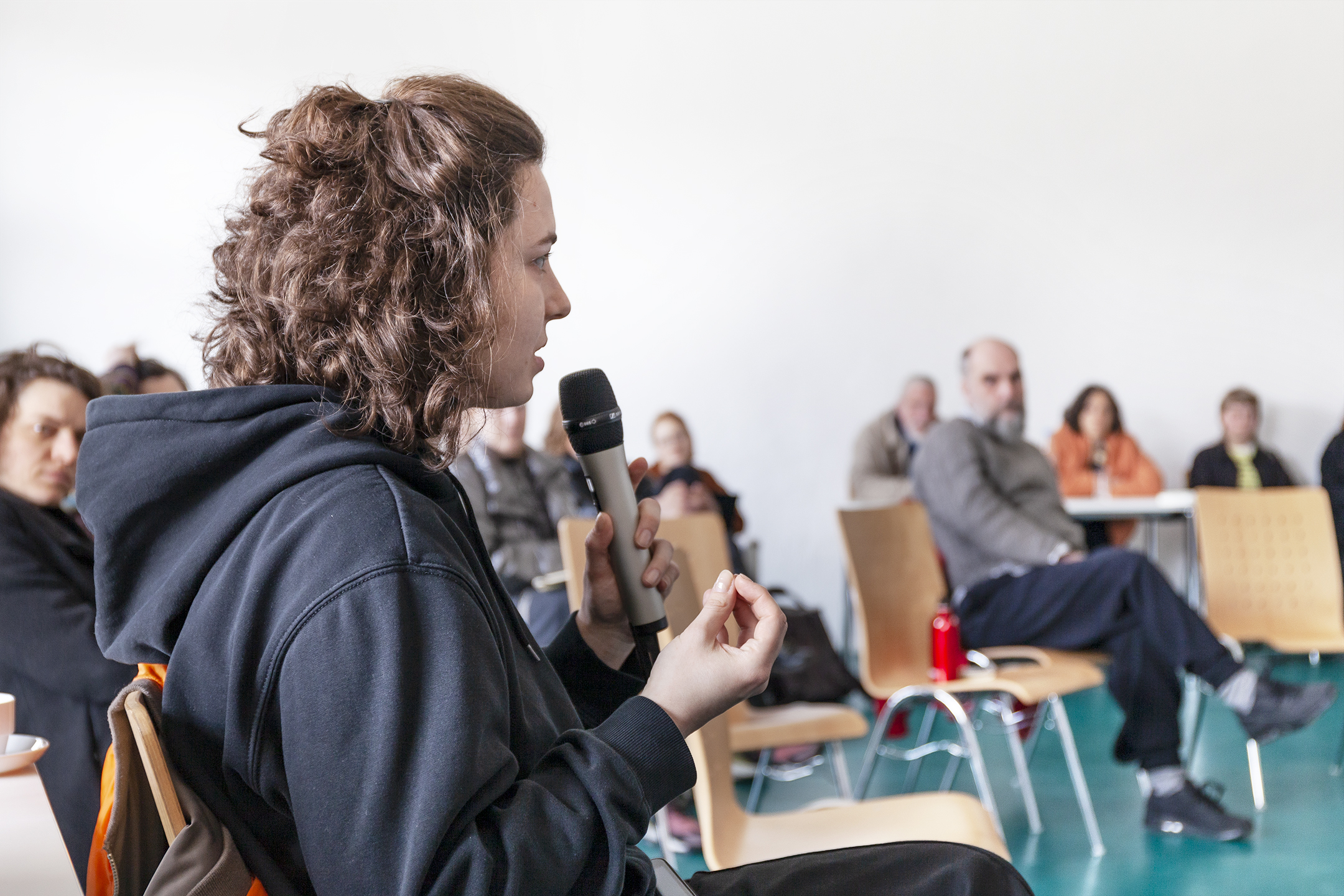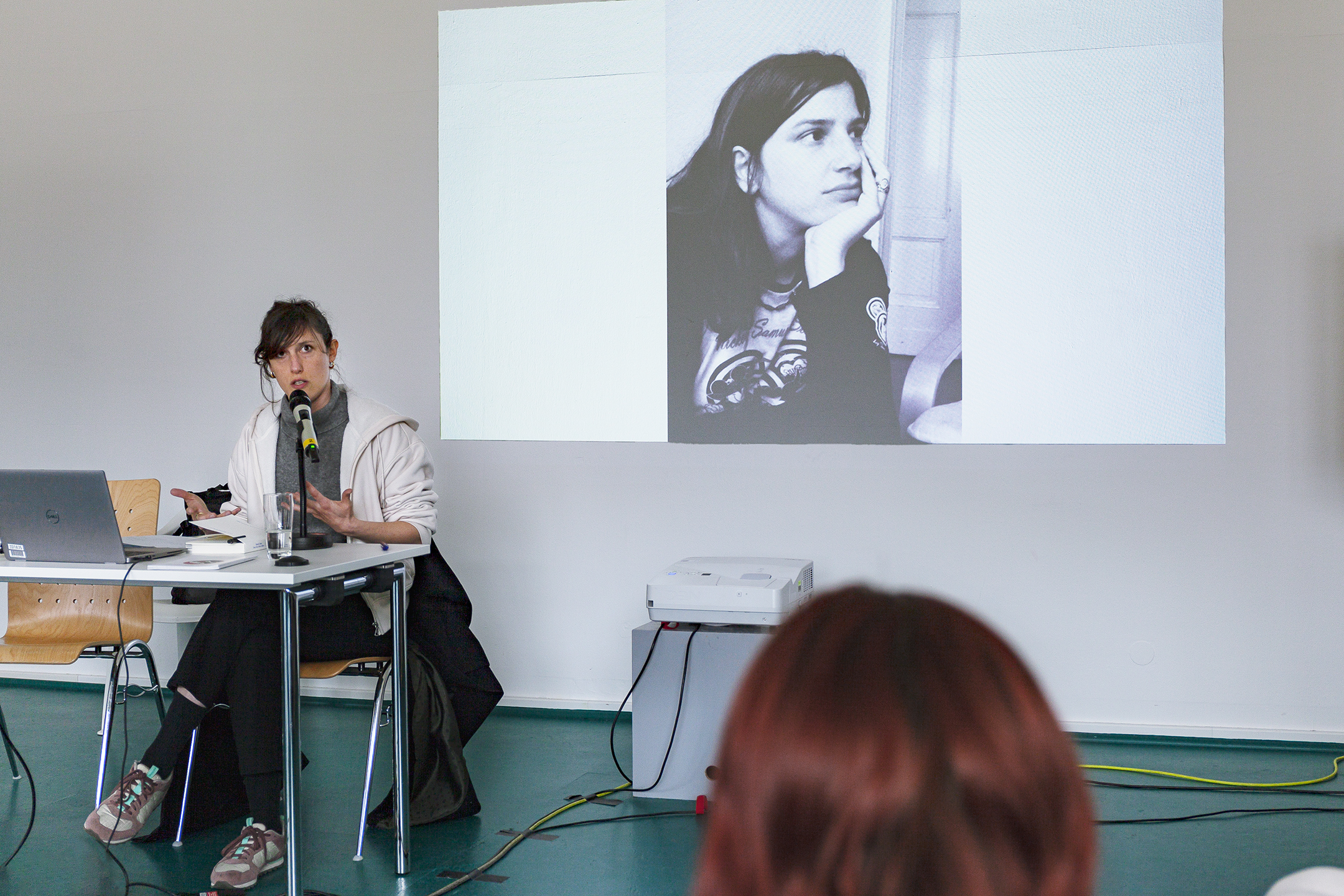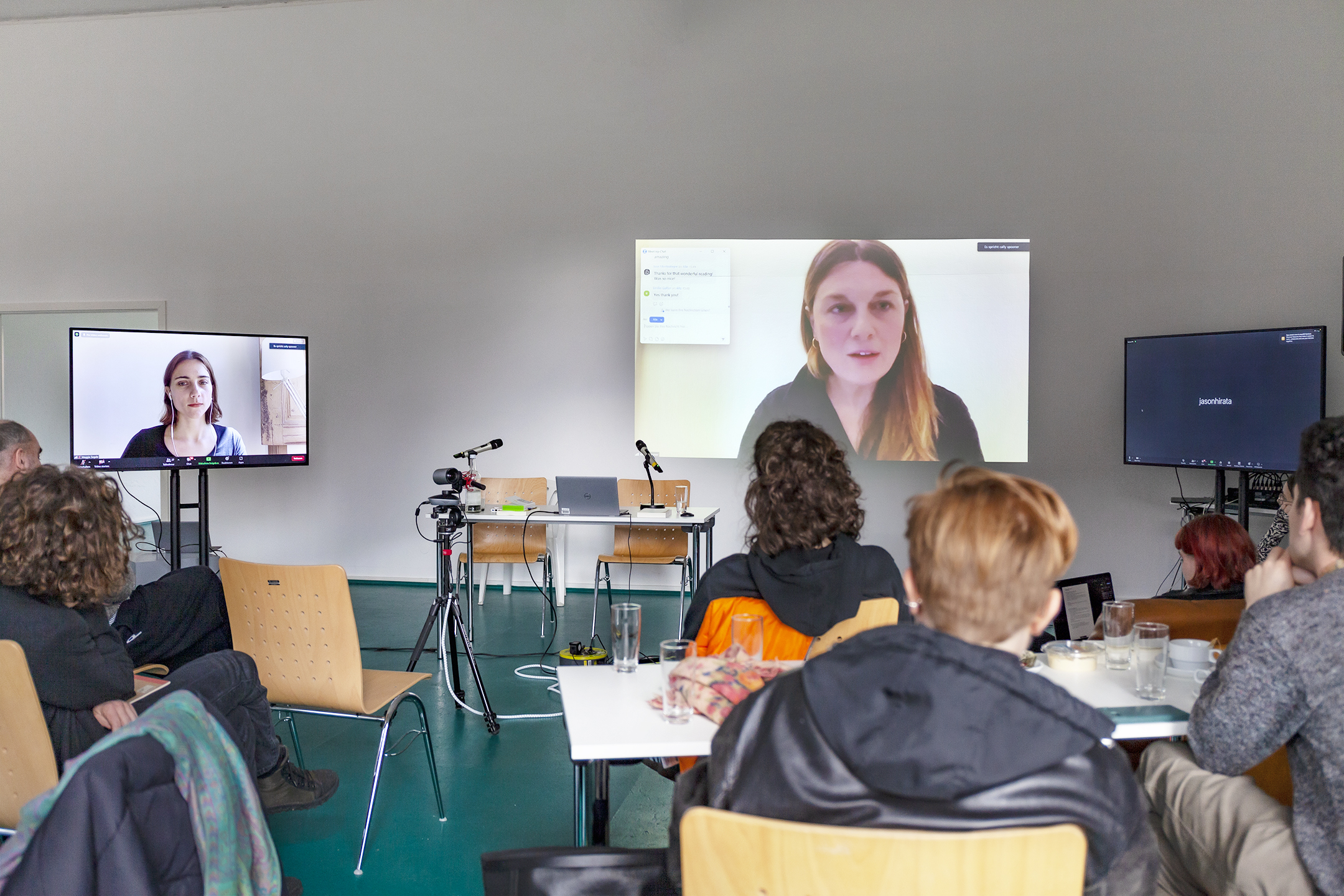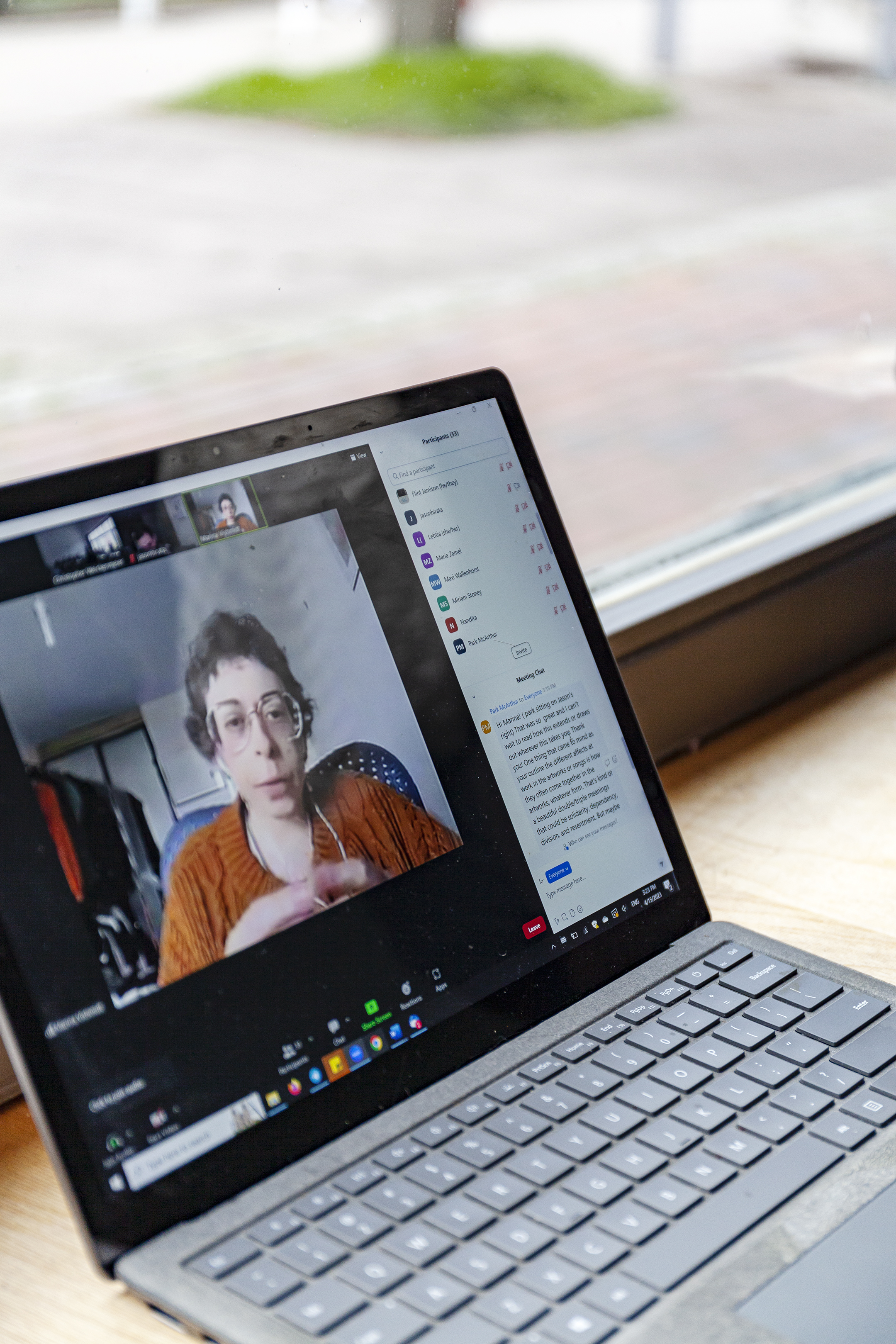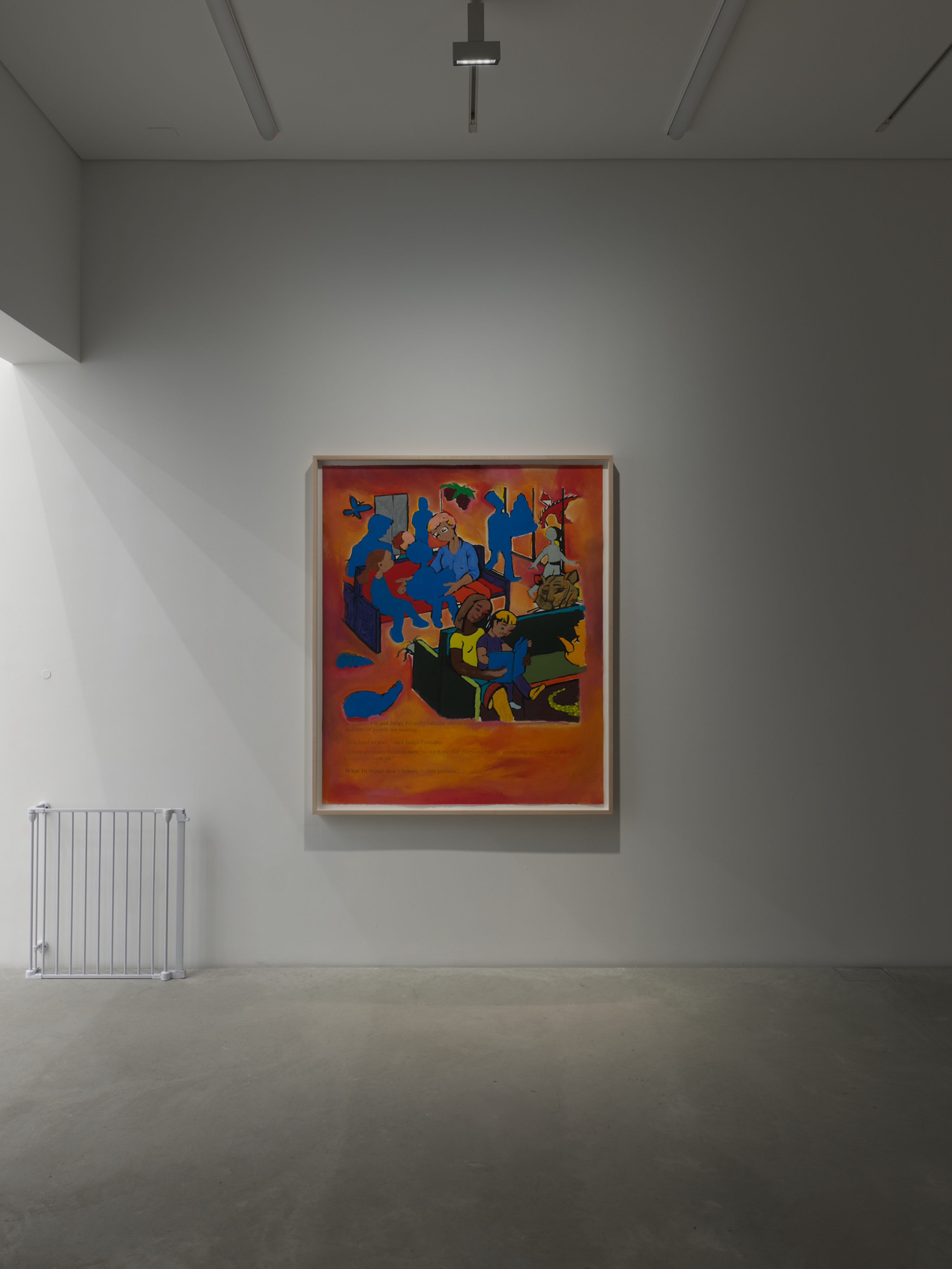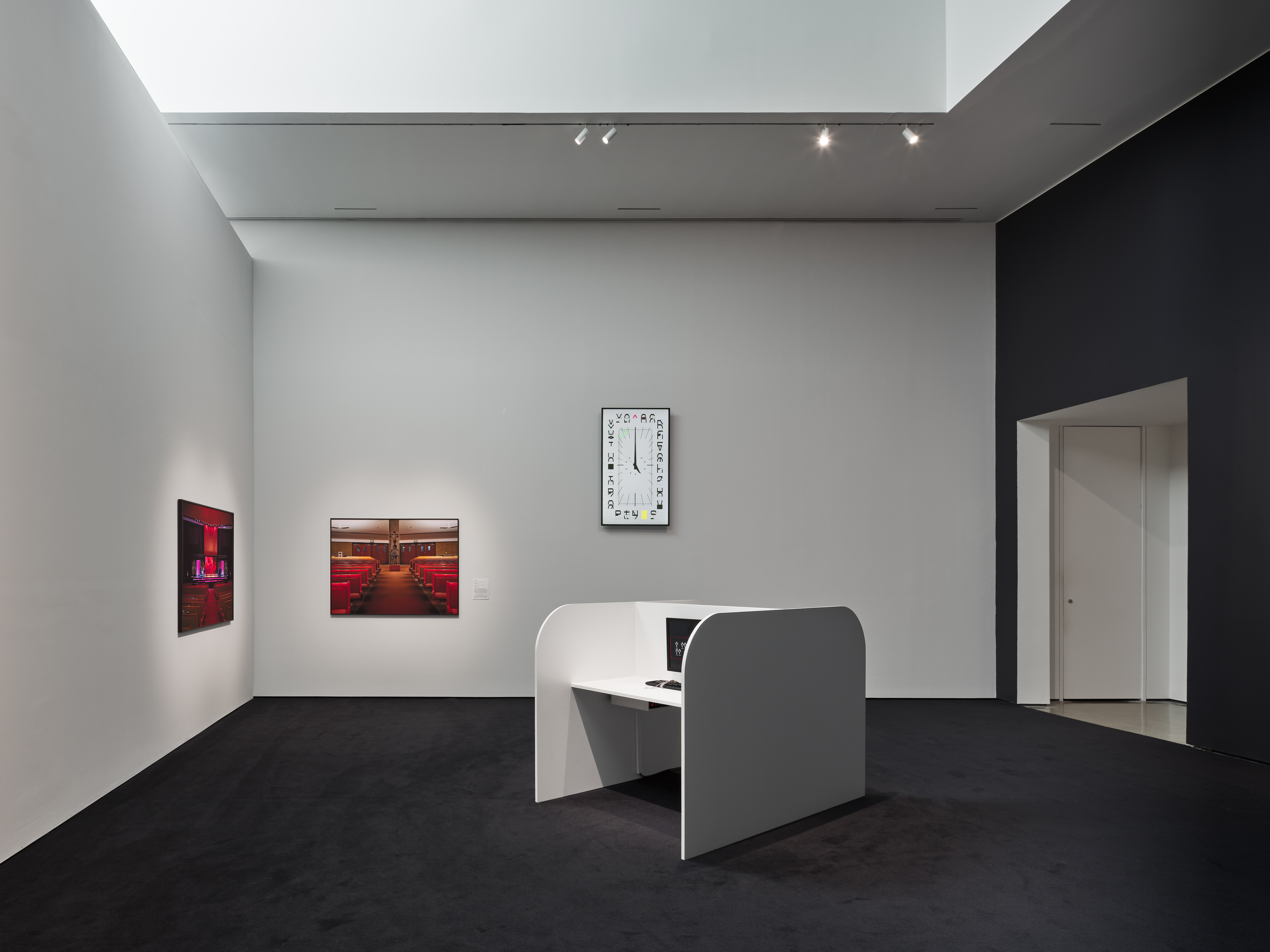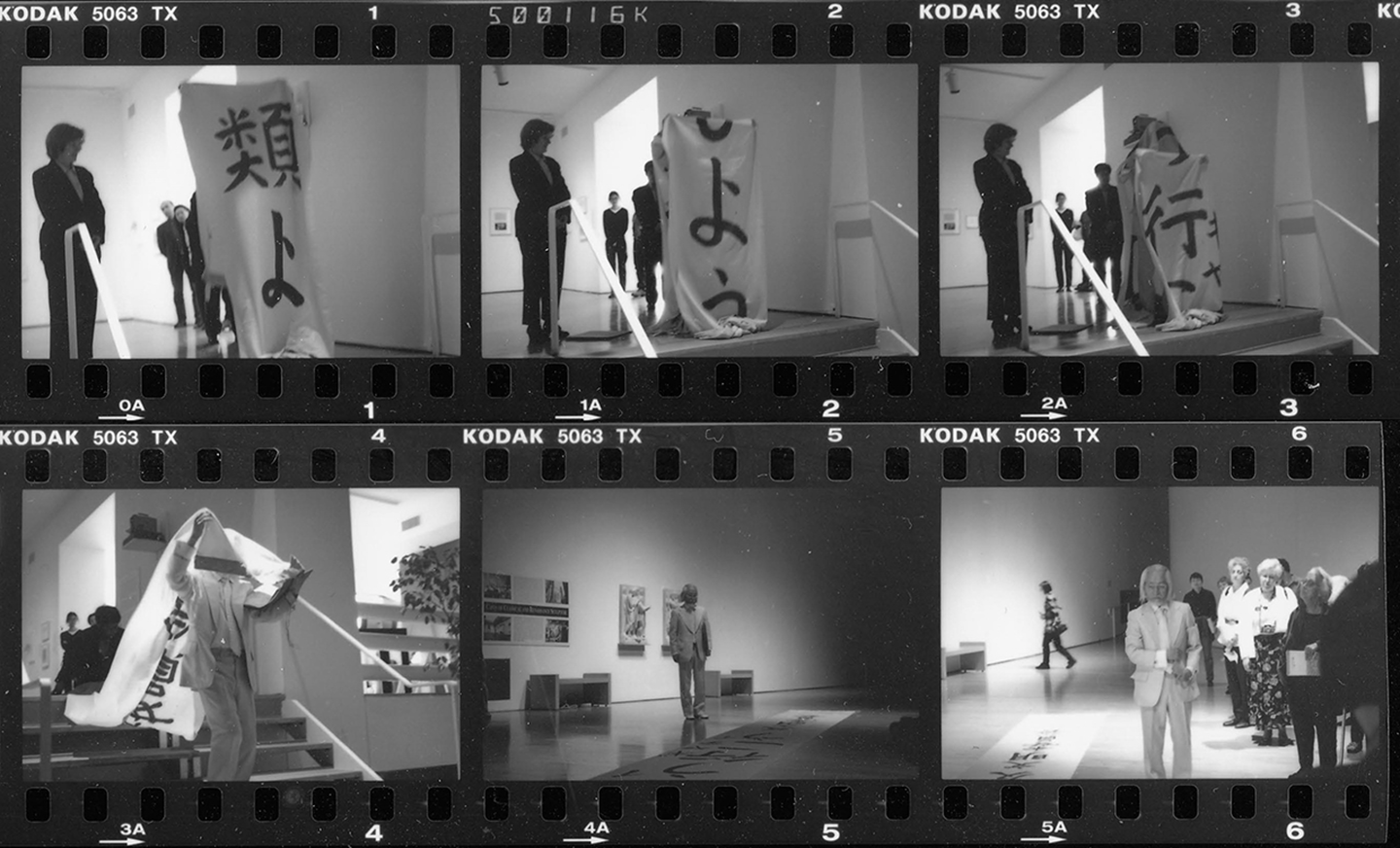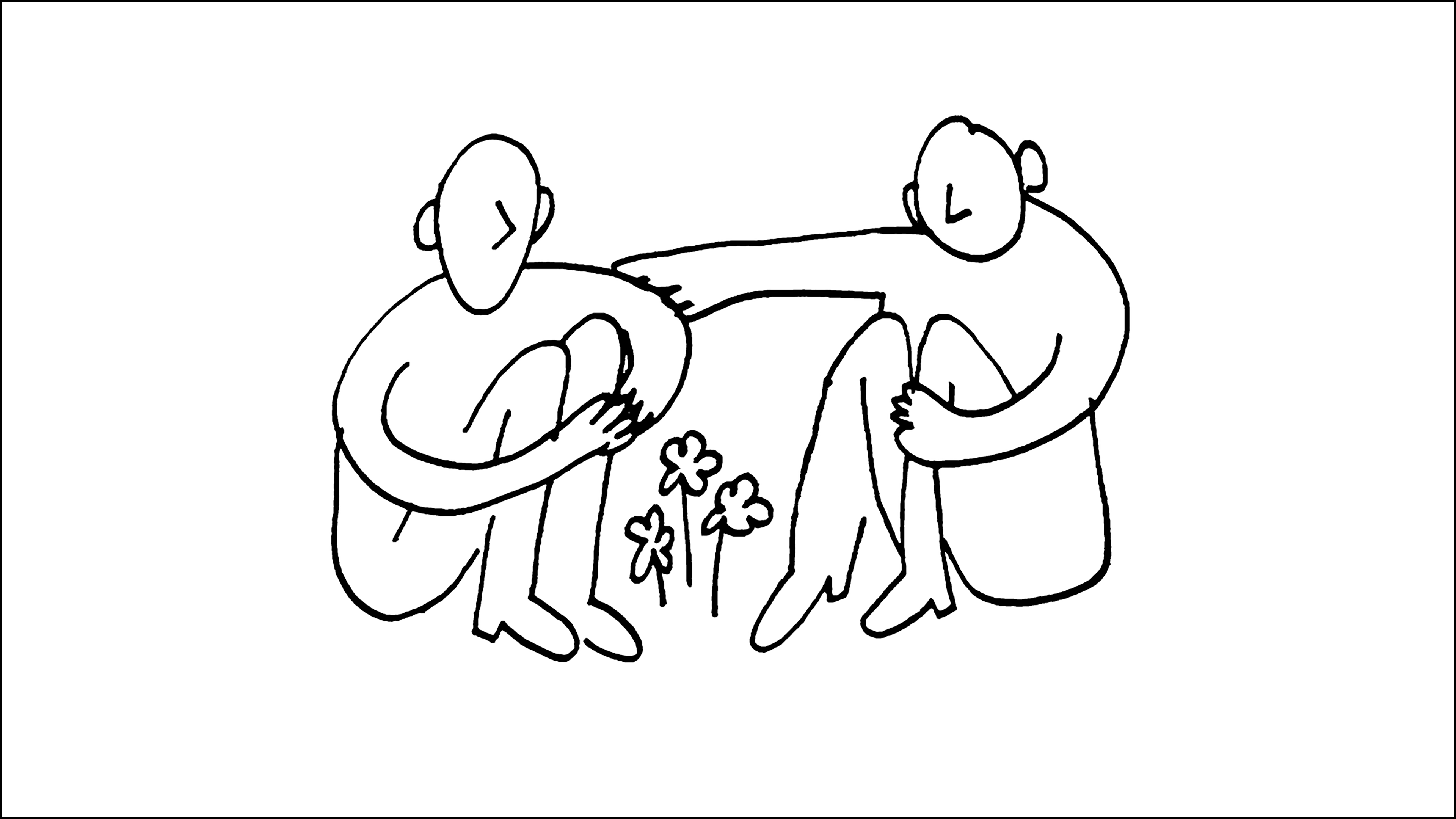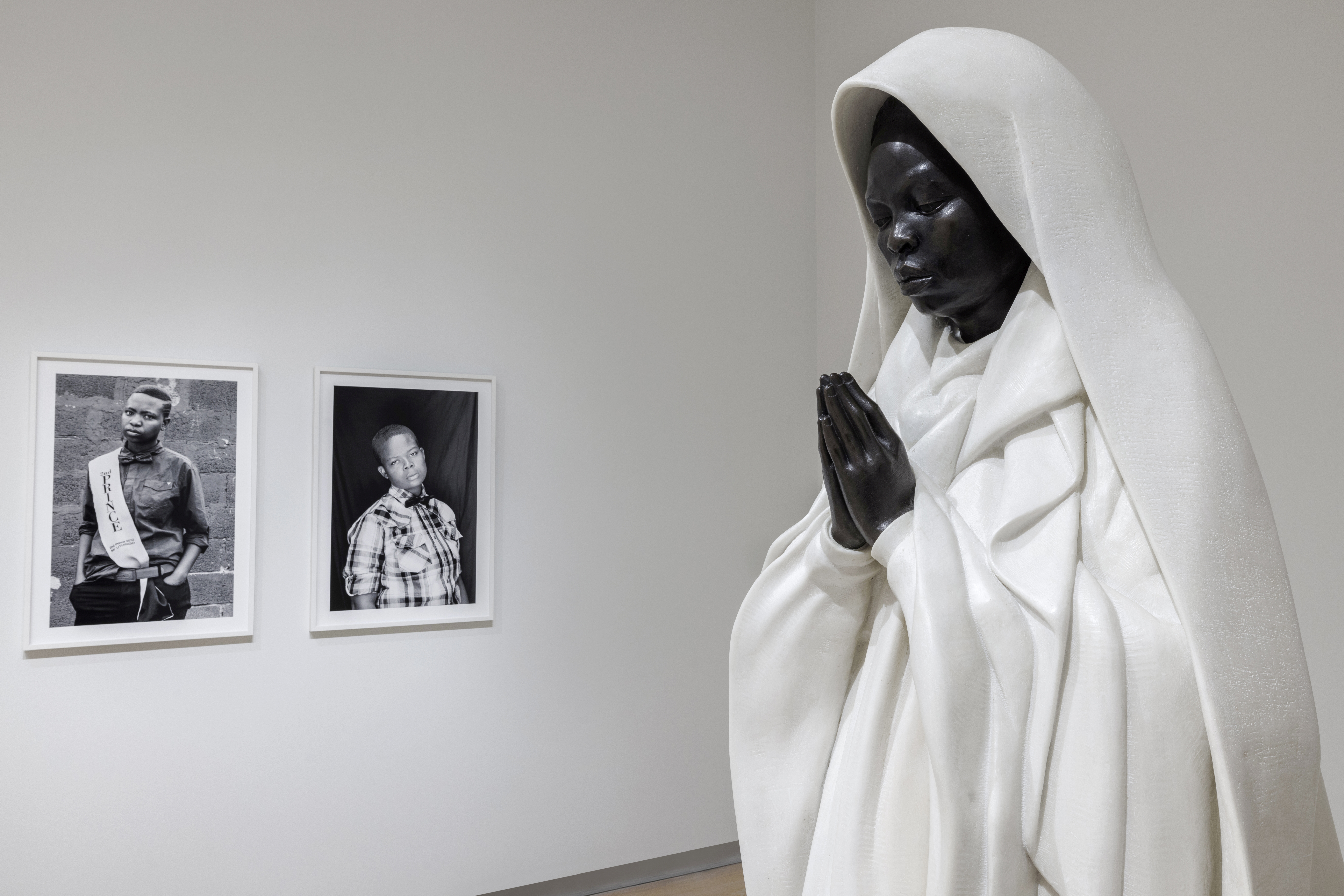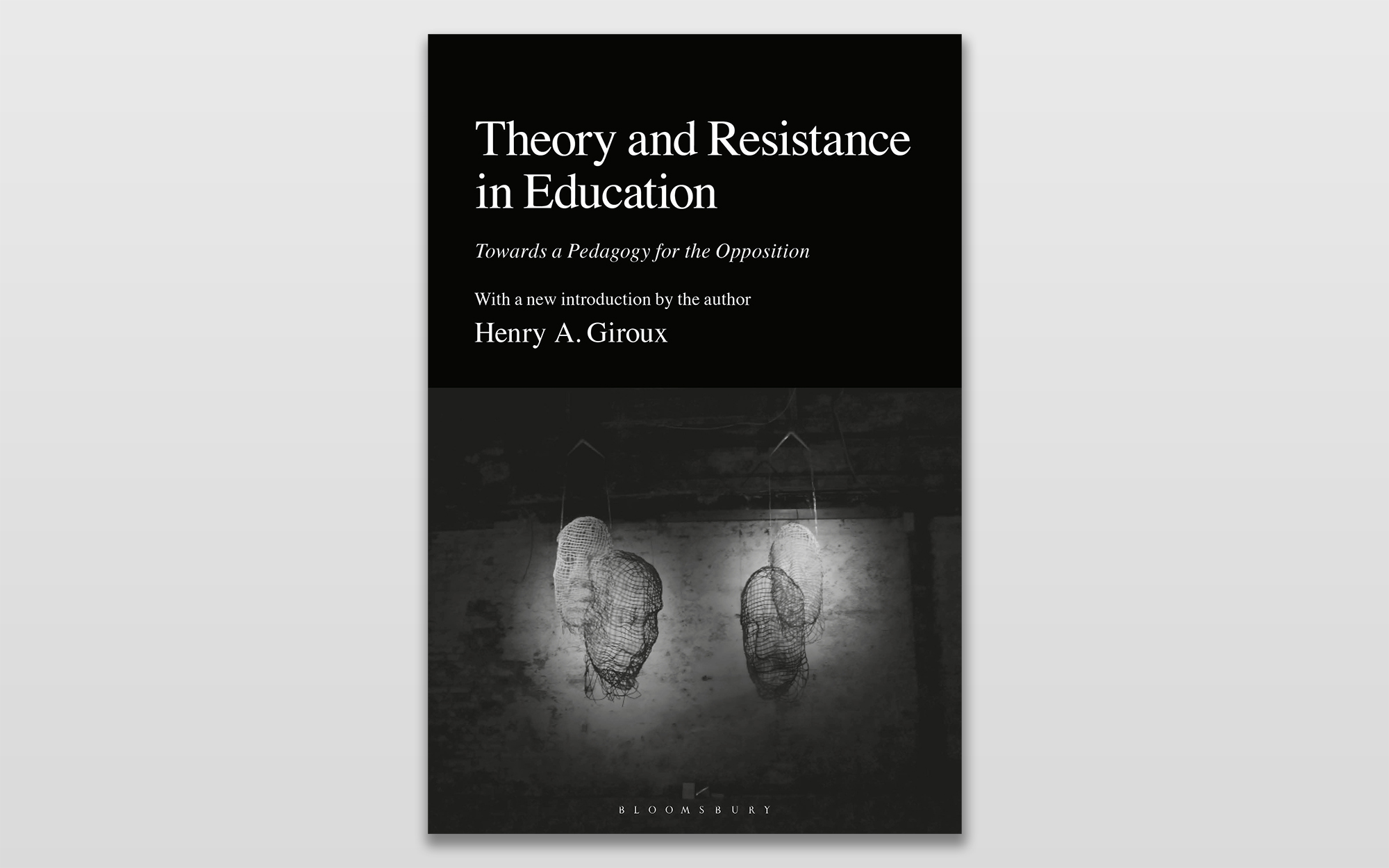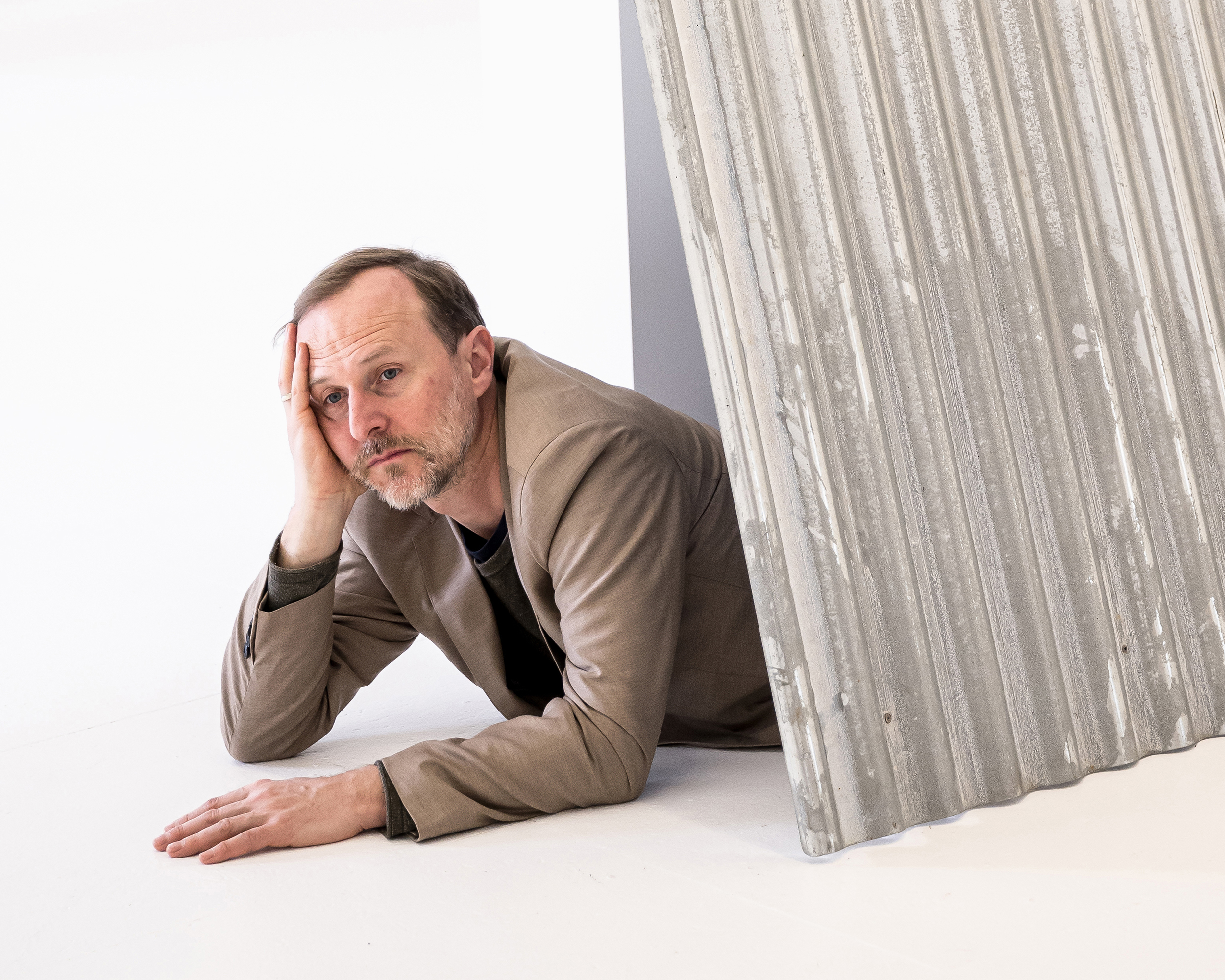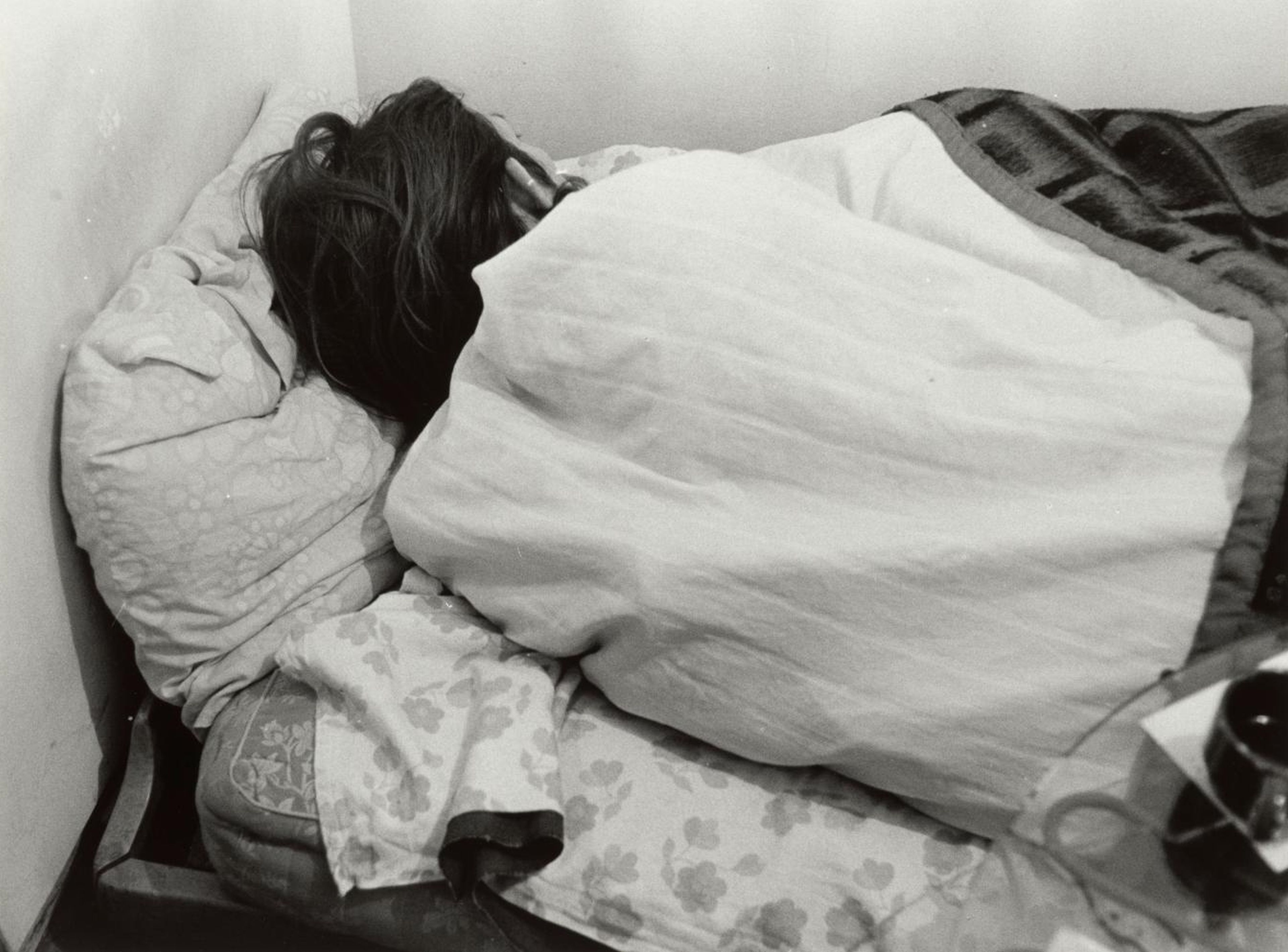https://kunstraum.leuphana.de/
To understand the context in which the workshop “Assistances (Working Title)” took place at Kunstraum, Leuphana University Lüneberg, April 14–15, 2023, one must look to its continuities and discontinuities with a seminal event held at the same institution thirty years earlier: “Services,” organized by Andrea Fraser and Helmut Draxler, from April 1993 to February 1994. [footnote For a comprehensive account of the working group and exhibition “Services: The Conditions and Relations of Service Provision in Contemporary Project Oriented Artistic Practice,” Kunstraum, Leuphana University Lüneburg (1993–94), see Eric Golo Stone, “Responding to the Relations and Conditions of Exhibitions: The ‘Services’ Working-Group Discussion Forum,” Afterall, no. 35 (February 2014) →.] “Assistances,” like “Services,” engaged the topic of artistic labor and gathered in an educational setting different practitioners—or rather, workers—involved in art production to trace theoretical inquiries into the political economies that determine the material conditions of art -making. Such situational and thematic continuities might suggest “Assistances” reprised the concerns of the earlier project, when, in fact, the workshop addressed a form of artistic labor that has proliferated in the art world of our time, shifting focus, as the organizers described it, to “the one doing much of the work—the assistant.” [footnote “Assistances (Working Title),” Kunstraum, Leuphana University Lüneburg →.]
“Services” noted a move from product-oriented art production toward the logic of the project, which brought with it a renewed division of labor, though without restructuring artists’ rights or remuneration. As artists like Fraser took up the mounting administrative work associated with project-based art in the 1990s, they found that they were not being adequately paid for their labor and its products, which were becoming increasingly immaterial. [footnote Andrea Fraser, “Services: A Wworking-Ggroup exhibition,” in Beatrice von Bismarck, Diethelm Stoller, and Ulf Wuggenig, eds., Games, Fights, Collaboration.: Das Spiel von Grenze und Überschreitung, ed. Beatrice von Bismarck, Diethelm Stoller, and Ulf Wuggenig (Stuttgart: Cantz, 1996). Republished at on Transversal, January 2002 (01 2001): →.] The 1993–94 “working-group exhibition” brought together artists and curators to “develop a framework for their activities that would integrate the practical and the theoretical, encompassing material and political as well as artistic concerns.” [footnote Ibid.] While “Assistances” was also concerned with the effects of the ongoing immaterialization of artistic labor, it presented significant discontinuities with its supposed predecessor, especially in regard to authorial and laboring subjectivities, perceptions of working interdependencies, and increasingly complex and scattered political economies of art production. Since Fraser and Draxler’s working-group exhibition, project-oriented work has precipitated further outsourcing and hierarchization, resulting in studio organizations that, for example, employ multiple assistants in research and concept development, accounting, administration, manual labor, and communications, as well as more blatant forms of reproductive labor. [footnote See, for example, the description of Studio Olafur Eliasson: “The team at Studio Olafur Eliasson consists of craftsmen and specialized technicians, architects, archivists and art historians, web and graphic designers, film-makers, cooks, and administrators. They work with Eliasson to develop, produce, and install artworks, projects, and exhibitions, as well as on experimentation, archiving, research, publishing, and communications.” →. I have also written about these developments in some detail in the article “Good Assistants,” dis/claim magazine, (2022), →.] The workshop and participants’ presentations testified to a renewal of perspectives on these matters, which no longer concern only artists and curators but also touch upon the material realities of academics, music producers, typographers, choreographers, students, and of course, assistants, however one understands this ascription.
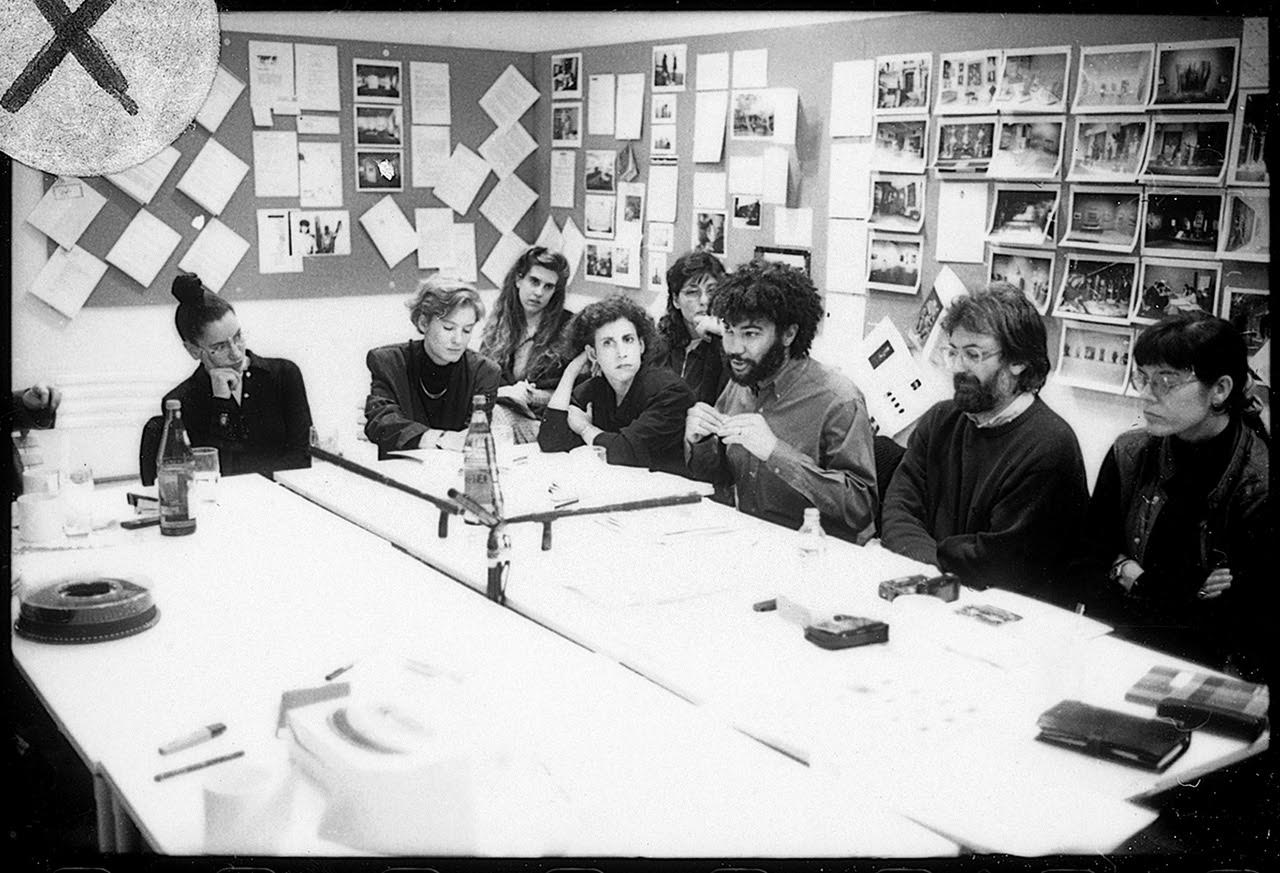
“Services,” working-group exhibition, Kunstraum, Leuphana University Lüneberg, April 1993–February 1994. Courtesy Kunstraum, Leuphana University Lüneberg.
Organized by Tamara Antonijevic and Christopher Weickenmeier, with student assistants Nina Bartnitzek, Manuel Clancett, and Patricia Fritze, “Assistances” focused its attention on the moment before art comes into existence, when responsibilities are still loosely distributed and the work ongoing. Taking place in the educational context of Leuphana University’s exhibition space, the workshop situated the work of assistance both within a pedagogical framework—as work experience, a part of an aspiring cultural worker’s tutelage—and also analyzed it as a cultural-scientific concept worthy of research and study. [footnote “Cultural-scientific” is a calqued translation of the German term “kulturwissenschaftlich,” which derives from the field of study “Kulturwissenschaft.” The majority of the students present at the workshop were enrolled in Kulturwissenschaft programs at Leuphana University Lüneburg.] Antonijevic and Weickenmeier both work as educators in German universities alongside their other occupations in art production and theater: Weickenmeier teaches a seminar at Leuphana University Lüneburg called “Assisting and the Arts of Services,” for which the workshop formed a part of the curriculum, and Antonijevic has worked extensively as an assistant and dramaturge in theater and now teaches expanded dramaturgy at the Academy of Fine Arts Nuremberg, where she engages with the rehearsal space as one of reproductive labor. Assistance, in theory and practice, is also embedded in the German educational context, whereby students may engage in the so-called freiwilliges soziales Jahr (voluntary social year). After completing compulsory education, those looking toward careers in the arts, for example, are often expected to take on (unpaid) work as assistants or interns before enrolling at a university. Assistance has become something like a rite of passage for becoming a worker in the arts sector, and yet discourses around art pedagogy tend to focus on students in institutions as if they were on a linear trajectory toward autonomous artistic subjectivity, without the ruptures and subjective fragmentations involved in, for example, taking up a supporting role as an assistant. [footnote For an exemplary overview of texts on artistic pedagogy, see: Felicity Allen (ed.), Documents of Contemporary Art: Education, ed. Felicity Allen (London: Whitechapel Gallery, 2011).] Like higher education itself, access to these forms of “experience” that can make one candidate more employable, more interesting, or simply more amenable than another is unevenly distributed, and the rules surrounding them somewhat opaque. To organize this public workshop in a university context, where forms of assistance to intellectual labor are something of an unspoken given, was therefore not only appropriate but also deeply necessary.
Before the workshop took place, Antonijevic and Weickenmeier shared with me the idiosyncratic processes by which they conceived of and organized the program. By inviting practitioners from various fields who work in mediums other than typical institutional exhibitions, they sought to facilitate a multiperspective approach to a discussion around assistance that would be avowedly materialist and attentive to ideas of authorship and autonomy. The workshop, they hoped, would recognize (and perhaps even address) the pressing need for a language with which to articulate the interdependencies that allow art to come into being. The assistant, insofar as this figure assumes any number of roles and positions—and is indeed defined by their malleability—ought to be understood as a loose embodiment of the pervasive precarity that makes art serviceable to institutions. The assistant is underpaid and overworked, useful until useless, overlooked and replaceable, and yet deeply and intimately intertwined with the labors and lives of their employers. Antonijevic and Weickenmeier condensed this description into the simple fact that the work of the assistant is generally the first to be outsourced by an artist because it is both the most urgent and the least desirable. The assistant, therefore, can be considered as the abject in art, so to speak.
Nevertheless, for as much as “Assistances” connected with the working group “Services,” the workshop ultimately precluded the possibility of centering the assistant as a hermetic, singular subject position. Perhaps for the best, since the assistant cannot be embodied in one way of working for or relating to any particular artist. The mutability of assistance has become increasingly evident as artistic work itself has diffracted, which Fraser and Draxler described in 1993 as a shift from products to projects in the aims of art- and exhibition- making. This development irrevocably complicates the material relations through which art production takes place: roles are continually reversed or revised, and responsibilities redistributed across artists, their studios, and the institutions that invite them to make exhibitions on their premises according to their terms and conditions. The diffraction of artistic work also formed the starting point of Fraser and Draxler’s protracted efforts to insert the institutional framework and its political and economic weight into public view in the exhibition. Then as now, their practices make visible the latent content behind exhibitions that are only nominally invested in emancipatory discourses, reflexivity, and certain limited forms of institutional critique. The participants in “Assistances” took up these thirty-year-old concerns in their own ways and according to their current investments and methodologies. Throughout the two days of discussions, however, certain questions continually resurfaced regarding the interrelations and contradictions between artistic services and forms of institutional representation, engaging along the way notions of complicity, compliancy, strategy, language, dependency, vulnerability, labor, organization, solidarity, and exchange.
Many of these terms resound in the work of Stefano Harney, both in his longstanding intellectual partnership with Valentina Desideri and in texts co-authored with Fred Moten. Desideri and Harney came together on site in Lüneburg for an informal conversation about their ongoing work. The mode of their contribution—open, meandering, spontaneous—mirrored the concept of “study” that Moten and Harney developed out of the contradictions they encountered between engaging with the Black radical tradition and working in the university. During the discussion, Harney (intentionally loosely) defined “study” as the thing you do for as long as you need to, with the people you need to do it with, in the place you need to do it. [footnote Further definitions of “study” are given in Stefano Harney and Fred Moten, The Undercommons: Fugitive Planning & Black Study (New York: Minor Compositions, 2013).] Moten and Harney have emphasized the antithetical relation between study and the university, as an institution structured to place obstacles in study’s way: the seminar table that dislocates the body from discussions; the insistence upon eventual graduation; the cost of tuition fees curtailing the financial viability of an indefinite endeavor. Desideri, citing the dance studio as an example, drew attention to the enduring nature of study, which requires constant rehearsal and repetition and the differences in thinking, practice, and gesture that emerge as a result. Disenfranchised by the university’s rhetoric of self-improvement and individualist strategizing—both outcomes of colonial logic—Desideri and Harney put forward the notion of “affordances” as that which might aid “decolonizing the senses” and thus break down the perceived separations between subject and object. Adopted from psychologist J. J. Gibson, who used the term “affordances” to contest Carl Jung’s notion of the archetype, Desideri and Harney introduced forms of language and organizing not centered around the needs or demands of the individual but rather tuned into what others make available to us. Thinking and working with affordances rather than prescribed roles or institutional expectations to deliver means remapping interdependencies across hierarchies in order to undo them.
Mathilde Supe’s publication Keren Cytter Does Not Like to Share (2023) offered a pertinent example of the ways in which interdependencies and perhaps also affordances become knotted, insofar as the complex conditions of her book’s production reversed the usual processes by which assistants help artists realize their work. [footnote Mathilde Supe, Keren Cytter Does Not Like to Share (Berlin: Sternberg Press, 2023).] For her contribution to “Assistances,” Supe described the conditions in which she wrote the book, in French, while working for the artist Keren Cytter. The precarity of Supe’s position is glossed over in a blurb on the publisher’s website: “Supe embarked on a journey to New York City, where she had never set foot, barely speaking English, without a work permit, and without contacts. From this incredible adventure, she transcribed every detail of hardship and learning in a book that took the form of a logbook and followed the evolution of one young artist’s view of another established artist” (emphasis my own). [footnote See →.] During the Covid-19 pandemic, Cytter read the book using translation software and decided to have it translated into English and published with Sternberg Press. Supe’s presentation at Kunstraum preceded a series of appearances alongside Cytter to promote the book and thus offered a unique opportunity to hear from the assistant independently of the artist. Even so, it became clear how the circumstances of the book’s publication blurred institutional and peer support and appropriation and authorial control, resulting in a narrative that is as much an intimate account of one artist’s working life as it is the assistant’s doomed attempt to articulate herself in her own terms.
The problem of the assistant’s capacity to speak for oneself came to the fore in the presentation by Cally Spooner and Will Holder, who were joined by Maggie Segale, seemingly at the last minute. With Spooner and Segale present via Zoom, and Holder acting as a mediator in situ in Kunstraum, the confusions and conflations of authorship and responsibility that Spooner so often engages in her work, which analyzes the contrivances and constraints of social situations, interestingly played out in the workshop in real time. Segale, a choreographer, collaborator of Spooner’s, and the namesake of the artist’s DEAD TIME (Maggie’s Solo), was not billed as a contributor to “Assistances,” and her presence in the context of the workshop opened up questions of Spooner’s dependency within the “architectures of care” that give rise to the artist’s work. Referring back to Harney and Moten’s notion of study as an open-ended spatio-temporal situation, Segale and Spooner relayed the undefined processes through which their collaborations took place. Navigating the budget, context, and parameters of an invitation, Spooner and Segale described the mediated communications and rehearsals that gave rise to DEAD TIME (Maggie’s Solo), a video work originally intended as remote, visual instruction to dancers interpreting a choreography that Segale would not be able to perform due to lockdown restrictions. Speaking candidly about the mishaps that their collaboration at times produced, the two described how their working relationship had to be reconfigured to make space for vulnerability and inability in a field where such conditions are otherwise often disparaged or ignored. In light of the general themes of the workshop, which dealt explicitly with the legacies of “Services” and the need to take political economy into consideration in artistic contexts, it seems relevant to me now to ask whether or not Segale was paid for her impromptu appearance at the workshop. What did her participation afford Spooner, if not only moral absolution for an inevitably hierarchical working relationship? Within the time constraints of the workshop, it was not possible to address these questions immediately, though it is pertinent to state here that workshops such as “Assistances” are themselves cultural events, which are just as ripe for critique as processes of art production and institutional exhibitions.
Speaking more generally, though in ways that resonate with (and perhaps prompted) the questions I have just raised, Eric Golo Stone pointed out in his presentation that the art sector is especially inventive when it comes to means and methods of managing wealth. His recourse to the artist’s “moral authority” in institutional contexts made plain the need for continual and unrelenting structural reflection on the immediate social conditions that materialize in exhibitions and workshops such as “Services” and “Assistances.” It is not enough to externalize questions around service work, its abuses, exploitations, and dispossessions, or its gendered and racialized aspects, and surface them as “content.” Thirty years on, one lesson from “Services” is that art-makers are adept in rendering, representing, displaying, and thematizing the there and then but less so the situational here and now. The discontinuity of the public nature of this workshop and the working group “Services,” to which only artists and curators were admitted, made evident the extent to which these matters must be addressed in exchanges of various perspectives, without relying solely on artists to arbitrate what art should be.
Terre Thaemlitz’s explicitly anti-spiritual refusal of the exuberant artist figure came through in her accounts of labor and representation in the field of “academic computer music.” As a music producer, Thaemlitz insists on demystifying and disenchanting artistic work, which has been dressed up in the languages of aesthetics, transcendentalism, and even love by “dominant employment systems,” among which Thaemlitz includes discourses that insist on a supposed surplus of pleasure in arts-sector jobs as compensation for unfair payment and poor working conditions. By speaking openly about the processes of drawing up and signing contracts, getting paid, and granting or withholding the rights to the products of one’s labor, Thaemlitz demonstrated the discordances between the bourgeois-liberal humanist declaration that all artists are essentially middle-class and the economic realities that compel those without preexisting wealth into an enduring state of precarity to pursue their artistic work. Taking seriously the economic aspects of this work, insisting on payment, and refusing free and unlimited access to one’s output also means creating the conditions in which solidarity can exist among people without obvious communal alliances. When people are paid properly, for example, they need not rely on or perpetuate collective indoctrination into the languages of faith and aesthetics when making art work. This might mean giving up on utopian dreams, Thaemlitz contended, if we are to work on present conditions with any degree of seriousness. [footnote See Kerstin Stakemeier and Marina Vishmidt, Reproducing Autonomy: Work, Money, Crisis and Contemporary Art (London: Mute, 2026), 92: “The same holds true for the unfulfilled utopia of avant-garde art as unalienated labour: it did not overcome the boundaries which separated its utopianism from the stark reality of the industrial (re)production surrounding it. Quite the contrary; this division was imported into contemporary art and prolonged there as a division within the modes of use to which its various media were subjected. This was, if you will, the capitalist fall from grace of conceptual art, in which exactly what signified the latter’s drive toward the ‘immaterialisation’ of artistic media was used to introduce an industrial division of labour: a system in which the materialisations of art were executed by installation teams, production companies, gallery assistants or ‘artist assistance.’ (This, incidentally, is the structure that within contemporary art is often naturalised as art’s autonomy.)”]
Whether the perception of roles as facts supports or hinders the work Thaemlitz proposed remains to be seen. Annick Kleizen takes on support roles in art production as a conscious move away from their institutional curatorial practice. While reluctant to self-describe as an assistant, they perform assistance work as a means of entering into complicity with the artist. The exchange elicited by this dynamic—with Kleizen and the artist both articulating their respective needs and co-creating a space of exchange—brings Kleizen closer to the work they understand as curating, as well as something like Moten and Harney’s study. At the same time, they recognize the art industry as one with predetermined structures where certain strategies may be beneficial for maintaining the “conspiracy without a plot” (to quote Desideri and Harney). Kleizen quickly opened the discussion up to all workshop attendees, which brought up questions about emotional attachment within artist–assistant relationships. In an interesting divergence from other positions articulated during the workshop, which sought to undo or escape hierarchies (e.g., Harney and Desideri; Thaemlitz), Kleizen suggested a tentative and highly strategic adherence to a “descriptive hierarchy” in art production that would allow the possibility for negotiation across assigned roles as one potential way of making the intimate entanglements between artists, assistants, and others bearable and even advantageous.
Nevertheless, one must consider what happens when labor relations become ethical relations, when work is regarded as anything but work, when the interpersonal obscures the material conditions that enable hierarchies and their abuses to emerge. Marina Vishmidt concluded her presentation with this important point, adding that clarifying the work between an artist and a collaborator or an assistant as a labor relation does not reduce it to a labor relation but rather makes the labor relation more dialogic; its complexity is recognized rather than being absorbed and unspoken. Reflecting on the breakdown of interclass solidarities as exemplified by the song “Waitress in the Sky” by The Replacements, Vishmidt pointed out the ways in which forms of labor are gendered and racialized, indeed, made other, as a way of negating their rights of acknowledgment, payment, and fair working conditions. If work is taken for granted, as assistance in art production often is, a certain disidentification with the job may appear to be the only way of enduring. Vishmidt’s is an important point, especially in the context of a workshop organized on the topic of assistance but in which the assistant as a subject rarely came into view. If this fact seems to raise the question of who would want to identify as an assistant, for instance, it is not to cast aspersions on the work but rather to inquire into the conditions that would make this work fulfilling and pleasurable rather than deleterious to the individual.
The final session of the two days made space for another moment of collective reflection, prompted by Jason Hirata and a short text that he compiled over the course of the workshop. Hirata’s practice makes visible the reciprocity of assistance within artistic communities, where services and skills are often exchanged between makers. In the exhibition “25 OCTOBER, 2015 — 12 MAY, 2019,” for example, Hirata showed works by other artists that had been loaned to him and that resulted from interdependent relationships of art -making and assistance. Taking up the concerns of Theodor Adorno as formulated in “Theses on Need” (1942), Hirata’s short text for the workshop began with the question “How can need be linked to production?” Understanding need as a social category, as Hirata contended, means seeing how dependency is both constructed and maintained through the work of care and provision. This is not to deny the reality of need but rather to insist upon the materialist underpinnings that allow some people to make more urgent demands on our time and resources than others. As the final contribution to the workshop, the concluding round of questions moved into discussions of care more broadly speaking, particularly within contexts of disability. Ending the workshop on this note made abundantly clear how assistance takes place in a continuum of different needs, not all of which can be condensed into a single figure or form of labor.
The “Assistances” workshop served as an important tangent and supplement to ongoing critiques of artistic autonomy, singular artistic subjectivities, and the capitalistic ideologies that are embedded within these concerns. [footnote Examples of these critiques usually come from queer-feminist and decolonial scholars, including important works by participants in “Assistances (Working Title)” such as: Valentina Desideri and Stefano Harney, “Fate Wwork: A Cconversation*,” ephemera: theory & politics in organization 13, no. 1 (2013): 159–76; Stefano Harney and Fred Moten, All Incomplete (New York: Minor Compositions, 2021); Kerstin Stakemeier and Marina Vishmidt, Reproducing Autonomy: Work, Money, Crisis and Contemporary Art (London: Mute, 2026); among others.] In recent years, collective work has been seen as a kind of antidote to the unsustainability of possessive individualism implied in artistic authorship, as exemplified by the 2021 Turner Prize, for which only artist collectives were nominated, or the December 2021 issue of Texte zur Kunst on the topic of “Collectivity.” [footnote The nomination of collectives was a direct response to impacts of the Covid-19 pandemic on art production: “The choice of collectives reflects the fact that few artists have been able to publicly show anything over the past year. It prompted judges to focus on groups of artists whose collaborative work has demonstrably continued, not always in the confines of a gallery.” Mark Brown, “Five Aart Ccollectives Sshortlisted for Turner Pprize,” in The Guardian, (May 7, 2021) →. Coincidently, the “Collectivity” issue of Texte zur Kunst also features an article by Helmut Draxler titled “DAS WIR-IDEAL / Zur Kritik der Kollektivität” (“THE WE-IDEAL / On the Critique of Collectivity”).] However, a move toward these forms of collective authorship does not account for the supporting roles that make authorship possible in the first place. By taking the investigation back into the processes—and not the products—of art production (as “Services” set out to do), the participants in “Assistances” made space to question the very means by which the exhibiting artist can be sustained as a material existence and a concept. Referring to practical examples (Supe; Thaemlitz; Holder, Spooner, and Segale; Kleizen) and the political economies through which art is made (Harney and Desideri; Golo Stone; Vishmidt; Hirata), the workshop initiated these discussions in an academic context with a concerted effort to include the students’ perspectives throughout. In doing so, the organizers, participants, and attendees (in situ and online) made a decisive break with the legacy of “Services” and its closed-door policy. By shaping the program around a pedagogical framework—hosting the workshop in the university’s exhibition space and building it into an ongoing seminar—“Assistances” makes the claim for a continual and in-depth interrogation of the hierarchies and interdependencies within which not only artists and curators must operate but also the whole gamut of cultural workers, whose roles do much more to problematize artistic autonomy and authorship than a multiplication of the artist-author into a collective ever could or would. With an awareness of the material implications of these hierarchies and interdependencies, the workshop addressed subjects that touched upon the immediate realities of many of the students present: a show of hands revealed that most had at some time worked as assistants. The proximity of the discussions to the lived experiences of the students and the active engagements of the participants with those in attendance served to intensify the relevance, urgency, and potential for structural change in the present, perhaps as a means to catalyze further change in the future.
For a comprehensive account of the working group and exhibition “Services: The Conditions and Relations of Service Provision in Contemporary Project Oriented Artistic Practice,” Kunstraum, Leuphana University Lüneburg (1993–94), see Eric Golo Stone, “Responding to the Relations and Conditions of Exhibitions: The ‘Services’ Working-Group Discussion Forum,” Afterall, no. 35 (February 2014) →.
“Assistances (Working Title),” Kunstraum, Leuphana University Lüneburg →.
Andrea Fraser, “Services: A Wworking-Ggroup exhibition,” in Beatrice von Bismarck, Diethelm Stoller, and Ulf Wuggenig, eds., Games, Fights, Collaboration.: Das Spiel von Grenze und Überschreitung, ed. Beatrice von Bismarck, Diethelm Stoller, and Ulf Wuggenig (Stuttgart: Cantz, 1996). Republished at on Transversal, January 2002 (01 2001): →.
Ibid.
See, for example, the description of Studio Olafur Eliasson: “The team at Studio Olafur Eliasson consists of craftsmen and specialized technicians, architects, archivists and art historians, web and graphic designers, film-makers, cooks, and administrators. They work with Eliasson to develop, produce, and install artworks, projects, and exhibitions, as well as on experimentation, archiving, research, publishing, and communications.” →. I have also written about these developments in some detail in the article “Good Assistants,” dis/claim magazine, (2022), →.
“Cultural-scientific” is a calqued translation of the German term “kulturwissenschaftlich,” which derives from the field of study “Kulturwissenschaft.” The majority of the students present at the workshop were enrolled in Kulturwissenschaft programs at Leuphana University Lüneburg.
For an exemplary overview of texts on artistic pedagogy, see: Felicity Allen (ed.), Documents of Contemporary Art: Education, ed. Felicity Allen (London: Whitechapel Gallery, 2011).
Further definitions of “study” are given in Stefano Harney and Fred Moten, The Undercommons: Fugitive Planning & Black Study (New York: Minor Compositions, 2013).
Mathilde Supe, Keren Cytter Does Not Like to Share (Berlin: Sternberg Press, 2023).
See →.
See Kerstin Stakemeier and Marina Vishmidt, Reproducing Autonomy: Work, Money, Crisis and Contemporary Art (London: Mute, 2026), 92: “The same holds true for the unfulfilled utopia of avant-garde art as unalienated labour: it did not overcome the boundaries which separated its utopianism from the stark reality of the industrial (re)production surrounding it. Quite the contrary; this division was imported into contemporary art and prolonged there as a division within the modes of use to which its various media were subjected. This was, if you will, the capitalist fall from grace of conceptual art, in which exactly what signified the latter’s drive toward the ‘immaterialisation’ of artistic media was used to introduce an industrial division of labour: a system in which the materialisations of art were executed by installation teams, production companies, gallery assistants or ‘artist assistance.’ (This, incidentally, is the structure that within contemporary art is often naturalised as art’s autonomy.)”
Examples of these critiques usually come from queer-feminist and decolonial scholars, including important works by participants in “Assistances (Working Title)” such as: Valentina Desideri and Stefano Harney, “Fate Wwork: A Cconversation*,” ephemera: theory & politics in organization 13, no. 1 (2013): 159–76; Stefano Harney and Fred Moten, All Incomplete (New York: Minor Compositions, 2021); Kerstin Stakemeier and Marina Vishmidt, Reproducing Autonomy: Work, Money, Crisis and Contemporary Art (London: Mute, 2026); among others.
The nomination of collectives was a direct response to impacts of the Covid-19 pandemic on art production: “The choice of collectives reflects the fact that few artists have been able to publicly show anything over the past year. It prompted judges to focus on groups of artists whose collaborative work has demonstrably continued, not always in the confines of a gallery.” Mark Brown, “Five Aart Ccollectives Sshortlisted for Turner Pprize,” in The Guardian, (May 7, 2021) →. Coincidently, the “Collectivity” issue of Texte zur Kunst also features an article by Helmut Draxler titled “DAS WIR-IDEAL / Zur Kritik der Kollektivität” (“THE WE-IDEAL / On the Critique of Collectivity”).
